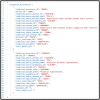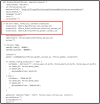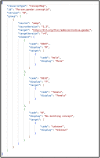MENDS-on-FHIR: leveraging the OMOP common data model and FHIR standards for national chronic disease surveillance
- PMID: 38818114
- PMCID: PMC11137321
- DOI: 10.1093/jamiaopen/ooae045
MENDS-on-FHIR: leveraging the OMOP common data model and FHIR standards for national chronic disease surveillance
Abstract
Objectives: The Multi-State EHR-Based Network for Disease Surveillance (MENDS) is a population-based chronic disease surveillance distributed data network that uses institution-specific extraction-transformation-load (ETL) routines. MENDS-on-FHIR examined using Health Language Seven's Fast Healthcare Interoperability Resources (HL7® FHIR®) and US Core Implementation Guide (US Core IG) compliant resources derived from the Observational Medical Outcomes Partnership (OMOP) Common Data Model (CDM) to create a standards-based ETL pipeline.
Materials and methods: The input data source was a research data warehouse containing clinical and administrative data in OMOP CDM Version 5.3 format. OMOP-to-FHIR transformations, using a unique JavaScript Object Notation (JSON)-to-JSON transformation language called Whistle, created FHIR R4 V4.0.1/US Core IG V4.0.0 conformant resources that were stored in a local FHIR server. A REST-based Bulk FHIR $export request extracted FHIR resources to populate a local MENDS database.
Results: Eleven OMOP tables were used to create 10 FHIR/US Core compliant resource types. A total of 1.13 trillion resources were extracted and inserted into the MENDS repository. A very low rate of non-compliant resources was observed.
Discussion: OMOP-to-FHIR transformation results passed validation with less than a 1% non-compliance rate. These standards-compliant FHIR resources provided standardized data elements required by the MENDS surveillance use case. The Bulk FHIR application programming interface (API) enabled population-level data exchange using interoperable FHIR resources. The OMOP-to-FHIR transformation pipeline creates a FHIR interface for accessing OMOP data.
Conclusion: MENDS-on-FHIR successfully replaced custom ETL with standards-based interoperable FHIR resources using Bulk FHIR. The OMOP-to-FHIR transformations provide an alternative mechanism for sharing OMOP data.
Keywords: HL7 Fast Healthcare Interoperability Resources (FHIR); Health Level Seven; electronic health records; health information interoperability; public health surveillance.
© The Author(s) 2024. Published by Oxford University Press on behalf of the American Medical Informatics Association.
Conflict of interest statement
B.Z. and J.A. are affiliated with an organization that has funding from the Massachusetts Department of Public Health for support and development of Electronic Medical Record Support for Public Health (ESP) and MDPHnet, which is the underlying technology of MENDS. All other authors declare no competing interests. No copyrighted materials were used in this article.
Figures





Update of
-
MENDS-on-FHIR: Leveraging the OMOP common data model and FHIR standards for national chronic disease surveillance.medRxiv [Preprint]. 2023 Nov 22:2023.08.09.23293900. doi: 10.1101/2023.08.09.23293900. medRxiv. 2023. Update in: JAMIA Open. 2024 May 29;7(2):ooae045. doi: 10.1093/jamiaopen/ooae045. PMID: 38045364 Free PMC article. Updated. Preprint.
Similar articles
-
MENDS-on-FHIR: Leveraging the OMOP common data model and FHIR standards for national chronic disease surveillance.medRxiv [Preprint]. 2023 Nov 22:2023.08.09.23293900. doi: 10.1101/2023.08.09.23293900. medRxiv. 2023. Update in: JAMIA Open. 2024 May 29;7(2):ooae045. doi: 10.1093/jamiaopen/ooae045. PMID: 38045364 Free PMC article. Updated. Preprint.
-
FHIR-Ontop-OMOP: Building clinical knowledge graphs in FHIR RDF with the OMOP Common data Model.J Biomed Inform. 2022 Oct;134:104201. doi: 10.1016/j.jbi.2022.104201. Epub 2022 Sep 9. J Biomed Inform. 2022. PMID: 36089199 Free PMC article.
-
OMOP-on-FHIR: Integrating the Clinical Data Through FHIR Bundle to OMOP CDM.Stud Health Technol Inform. 2025 May 15;327:667-671. doi: 10.3233/SHTI250432. Stud Health Technol Inform. 2025. PMID: 40380541
-
HL7 Fast Healthcare Interoperability Resources (HL7 FHIR) in digital healthcare ecosystems for chronic disease management: Scoping review.Int J Med Inform. 2024 Sep;189:105507. doi: 10.1016/j.ijmedinf.2024.105507. Epub 2024 Jun 4. Int J Med Inform. 2024. PMID: 38870885
-
Designing Interoperable Health Care Services Based on Fast Healthcare Interoperability Resources: Literature Review.JMIR Med Inform. 2023 Aug 21;11:e44842. doi: 10.2196/44842. JMIR Med Inform. 2023. PMID: 37603388 Free PMC article. Review.
Cited by
-
SQL on FHIR - Tabular views of FHIR data using FHIRPath.NPJ Digit Med. 2025 Jun 9;8(1):342. doi: 10.1038/s41746-025-01708-w. NPJ Digit Med. 2025. PMID: 40490535 Free PMC article.
-
The role of open standards in catalysing knowledge transfer to deliver climate adaptive care.NPJ Digit Med. 2025 Apr 7;8(1):191. doi: 10.1038/s41746-024-01401-4. NPJ Digit Med. 2025. PMID: 40195416 Free PMC article.
References
-
- Lee P, Abernethy A, Shaywitz D, et al.Digital Health COVID-19 impact assessment: lessons learned and compelling needs. In: Adams L, Ahmed M, Bailey A, et al., eds. Emerging Stronger COVID-19: Priorities Health System Transformation. National Academies Press; 2023: 177-234. 10.17226/26657. - DOI
LinkOut - more resources
Full Text Sources
Miscellaneous
